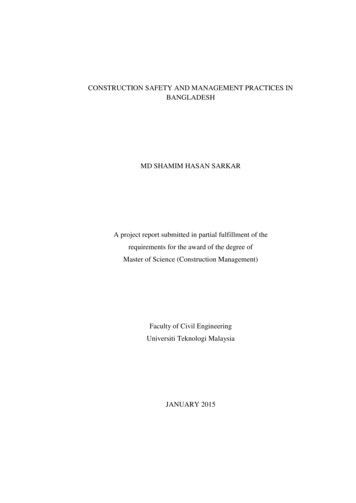
Transcription
MANUAL ON THE CONSTRUCTION OF A SOLAR WATER HEATERBACIBOWOT2004- Non-profit consultancy for solar energy in developing countries.- Knowledge centre for small-scale applications of sustainable energyand hand pumps for developing countries.
Table of Contents1. Introduction. 3Manual and Videotape . 31.1. Using solar energy. 31.2. Parts of the solar water heater . 41.3. Working principle of the solar hot water system . 41.3. Working principle of the solar hot water system . 51.4. The use of hot water systems . 52. Construction of the solar collectors . 62.1. Constructing the absorber . 72.1.1. Preparing the ½” galvanised pipe . 72.1.2. The pipe-bending set. 8Constructing the wooden frame for the pipe-bending set. 8Preparing the pipe-bending set . 112.1.3. Starting the pipe bending. 13The pipe bending procedure. 162.1.4. The cutting of the galvanised sheet. 192.1.5. Preparations to join zigzag-pipe and sheet . 202.1.6. Connecting the pipe and sheet . 21Connecting the pipe and sheet with wire loops . 21Connecting the pipe and sheet by riveting. 22Connecting the pipe and sheet by soldering. 232.1.7. The painting of the absorber. 262.2. Construction of the collector-box. 272.2.1. Preparations to make the wooden collector-box. 282.2.2. Constructing the wooden collector-box . 282.3. Preparing the insulation layer . 302.4. Preparing the glass cover of the collector. 313. The insulated storage tank and accessory pipe-connections . 33The soldering procedure. 34The insulation of the storage tank. 35The metal envelope and the cap. 374. The buffer tank . 385. Determining the location and position of the solar hot water system. 396. The foundation . 397. The installation of the solar powered hot water system. 40Placing the collectors . 41Placing the storage tank. 42Testing the hot water system . 43The insulation of pipe connections . 43Other collector set-ups . 438. Maintenance . 44Checking enclosed air in the system . 44Checking dust . 459. Financial aspects and labour costs. 4610. Time-span of the project . 4611. Summary of needed materials to construct one system . 46Appendix - Construction of a saddle-press. 47Zig zag collector, manual on the construction of a solar water heaterPage 2
1. IntroductionHealth and social communities in developing countries are institutes that daily use large quantities of hotwater. When such communities are situated in areas that are hardly accessible, they mainly use wood fuel forwater heating. Because firewood supply becomes an ever-growing problem, it is sensible to look for analternative source of energy. Given the fact that solar radiation is present in abundance, it seems justified tomanufacture self-made hot water systems.Manual and VideotapeThis manual is based on experiences gained during many years of building solar powered hot water systemsin developing countries. It may be helpful in constructing solar collectors and building hot water systemsespecially for communities using large quantities of hot water.By means of existing technical facilities, a selected group of skilled technicians and locally availablematerials, it is possible to produce zigzag collectors and to build up sustainable hot water systems. By usingclear explanations and many pictures we hope to be of service to those who are motivated to build a hotwater system all by themselves.Since 1997 a videotape entitled “Heated by the sun” has been composed as an additional illustration of themanual. It shows all activities as described in the manual. Therefore it is advisable to use the manual andvideotape jointly. The videotape can be acquired from the BACIBO-foundation.1.1. Using solar energyThe pluriform influence of solar radiation on life on earth can be used for several purposes. Provenapplications for among other things generating electricity, water heating, cooking, and crop drying with solarenergy exist. Small amounts of electricity can be generated with so-called P.V.-systems (Photo-Voltaic).These systems can be reliable energy providers for remote areas (in which sometimes hospitals and clinicsare situated). P.V.-systems are rather expensive. For maintenance and repair you need the manufacturersassistance. P.V.-systems can be used for: Lighting; Cooling boxes for storing medicines and blood plasma; Radio communication and T.V.For solar powered water-heatingtechnical appliances are rathersimple and much cheaper thanP.V.-systems. Institutions likehospitals require a substantialsupply of hot water 24 hours aday. Because the use of solarradiation is limited to the dailyhours of sunshine, it is necessaryto construct a hot water systemthat collects as much heat aspossible during the daytime andpreserves the collected heat asmuch as possible after sunset. Forthis reason a hot water systemhas been figured out which isnamedthethermo-syphonsystem, or the system based onnatural circulation.lampPV panelschargecontrollerbatteryOverview of a typical installation of a P.V.-system for electricity generation.Zig zag collector, manual on the construction of a solar water heaterPage 3
1.2. Parts of the solar water heaterThe solar water heater consists of the following parts, see the figure;1. The solar collector, in which water is heated by solar radiation.2. An insulated storage tank, in which the heated water from the collector is stored. The storage tank mustbe put higher than the top of the collector.3. An insulated pipe connecting the lower part of the collector and the upper part of the storage tank.4. An insulated pipe connecting the lower part of the storage tank and the bottom of the collector.5. A cold water inlet connecting an existing water supply system to the storage tank. Usually the coldwater inlet runs via a buffer tank with a floating gauge.6. An insulated hot water outlet running from the storage tank to the tap.7. A vent (air escape pipe) to prevent overpressure, caused by air or steam.floatinggauge7: ventwater supply systembuffer tank6: hot water tap3: hot water flow5: cold water inlet2: storage tank4: cold water flow1: solar collectorParts of the solar water heater.Zig zag collector, manual on the construction of a solar water heaterPage 4
storage tankwaterflow 0,5 mcollectorwater flowThe working principle of natural circulation.1.3. Working principle of the solar hot water systemWhen solar radiation heats the collector, the water inside will be heated as well. The heated water startsrising through the connection on top of the collector to the insulated storage tank. Heated water entering thestorage tank displaces cooler water that is in turn forced via the connection to the bottom of the collector. Inthis way a circulation comes into being. We call it natural circulation or thermo-syphon principle. The coldwater -entering the collector- will be heated again by solar radiation. Because the water temperature insidethe collector becomes much higher than inside the storage tank, the natural circulation continues as long asthe sun heats the collector. Consequently, the water inside the storage tank will get hotter and hotter.Depending on the amount of solar radiation and insulation, the system can produce water temperaturesbetween 40 and 70 degrees Celsius.1.4. The use of hot water systemsIf we want to use the hot water in the storage tank, we have to tap it. When hot water is tapped, the storagetank must be refilled. Therefore the storage tank is connected via a buffer tank to an existing water supplysystem (for instance a big rainwater tank or a borehole). The buffer tank is provided with a floating-gauge orball-valve. When tapping a bucket of hot water, the system will be refilled automatically via this floatinggauge.The efficient use of a hot water system depends on the daily need. For various institutions like hospitals,rehab centres, children homes etc. different quantities of hot water at different temperatures and for differentpurposes are required. The efficiency of the hot water supply depends on the way in which it is organisedand controlled by the management of the concerning institute. The average heating up period per system perday can be put at 6 hours. When a system is properly insulated, hot water can be drawn 24 hours a day. Soeven at night hot water can be used. Practice has shown that solar powered hot water systems are especiallyuseful for laundries and washing patients. With optimal use of a solar powered hot water system, a saving ofup to 70% of the usual firewood consumption can be achieved.Zig zag collector, manual on the construction of a solar water heaterPage 5
2. Construction of the solar collectorsA solar collector consists of 4 parts:1. The absorberThis is a dull-black painted metal body on which the zigzagpipe containing the water is fixed. The black coatingabsorbs almost all the solar radiation that falls on it. Thecollected radiation is transformed into heat andsimultaneously heats the water inside. Temperatures of 100ºC or more can be reached.glass sheetabsorber2. The casing or collector boxThe absorber is put into a box made of wood with a depthof 10 to 15 cm. The absorber is adjusted about half way thetotal depth so that there is sufficient space underneath aswell as above the absorber.insulationthe casing orcollector box3. The insulation layerThe space underneath the absorber is filled with insulationmaterial that retains the heat of the absorber. Usually theinsulation layer should be about 5 cm thick.4. The cover sheetTo retain the heat in the collector, the box is covered byglass. Thickness of the glass-sheet must be at least 4 to 5mm. The glass-sheet allows sunshine to pass throughwithout absorbing too much solar radiation. Also, itprevents the cooling of air by wind.The collector consists of a cover sheet,absorber, insulation and casing.Zig zag collector, manual on the construction of a solar water heaterPage 6
2.1. Constructing the absorberThe absorber consists of 2 items:1. A half-inch galvanised pipe at standard length of 6metres. The pipe must be shaped into 7 bends and 2squared ends.2. A galvanised sheet with a length of 110 cm, a width of80 cm and a thickness of 0,5 to 1 mm. The zigzag-pipeis fixed to the sheet and then painted dull-black.2.1.1. Preparing the ½” galvanised pipeThe following tools are needed:- a pipe-holding clamp- a pipe-cutter or hacksaw- a thread-cutter- a folding ruler or measuring rod- a marker (felt pen)The following materials are needed:- 3 half-inch galvanised pipes (for 3 collectors)For 1 hot water system 3 absorbers are needed. So we startto prepare 3 pipes at once. Normally each pipe has 2sockets fixed at both ends. Remove the sockets and put thepipes parallel to one side against a wall. (see picturealongside).mark½½Put the galvanised pipes parallel to a wall and mark the pipes at the same length.Take the shortest pipe as standard and mark all pipes at the same length. Cut the pipes straight at theindicated length by means of a pipe-cutter or hacksaw. On the shortened ends we make a half-inch thread bymeans of a thread-cutter. Check the screw thread of all pipes at both sides by means of a half-inch socket. Ifthe socket can be screwed on by hand, it’s ok. Keep the socket on to protect the thread while bending thepipe. Mark the middle of each pipe with a folding ruler. Mark it all around. Now the pipes are ready to bebent.Zig zag collector, manual on the construction of a solar water heaterPage 7
2.1.2. The pipe-bending setThe pipe-bending set consists of 2 parts:- a wooden frame fixed to an existing bench- an iron bending set, to be fixed to the wooden frameThe wooden frame -composed of different blocks- is needed to support the bending set. It also provides thehorizontal zigzag-shape of the pipe. The wooden frame has to be made of strong timber.The pipe-bending set consists of interacting iron parts.It also provides the horizontal zig zag-shape of the pipe.The wooden frame is needed to support theiron parts of the pipe bending set.Zig zag collector, manual on the construction of a solar water heaterPage 8
Constructing the wooden frame for the pipe-bending setThe following tools are needed:- a big hand saw of sawing machine- a carpenters square- a folding ruler- a marker- a hammer- a plane- a chisel- a drill (4-6-8 mm.)- a screw-driverThe following materials are needed:- sturdy timber- screws (thickness at least 6 mm.)- bolts and nutsSaw 2 blocks with the following measurements(see picture alongside)- length 50 cm- width 16 cm- thickness 4 cm. Mark the 2 blocks with A and B.Saw 1 block with measurements:(see picture alongside)- length 75 cm- width 16 cm- thickness 4 cmCut out at 4 cm. from the end of one long side arectangular space of 8 cm. by 8 cm. (see picture).Mark the block with C.Saw 1 block with measurements:(see picture alongside)- length 34 cm- width 16 cm- thickness 4 cm. Mark the block with B-2.Zig zag collector, manual on the construction of a solar water heaterPage 9
Join the block A, B, and C together as shown inpicture alongside.Then fasten block B2 onto block B.Saw 1 block with measurements:(see picture alongside)- length 25 cm- width 18,5 cm- thickness 8 cmMark block with DFasten block D onto block C as shown in picturealongside.Saw 2 planks of the following measurements(see picture alongside).- length 60 cm- width 16 cm- thickness 2,5 cmCut out at one end of the long side a rectangular spaceof 8 cm. from the top and 9 cm from the middle. Putboth planks against block A and B. Both planks musttouch block C. Block D fits into the space. Now fastenthe planks to block A and B. The wooden frame iscomplete.Zig zag collector, manual on the construction of a solar water heaterPage 10
Preparing the pipe-bending setThe following tools are needed:- a drill-brace and drills- some spanners (ring spanner nr. 17)- a screw-driver- some adjustable wrenchesPut the wooden frame on an existing bench.The bench must be a very stable one becauseof the forceful power needed to bend thepipes.Pay attention that there is a free space with aradius of at least 3 metres around point X ofthe wooden frame. (see picture below)The wooden frame for the pipe-bending set is completed.B2DC3 metresPay attention that there is a free space with a radius of at least 3 metres aroundpoint X of the wooden frame.Zig zag collector, manual on the construction of a solar water heaterPage 11
Put groundplate E on the indicated place ofthe wooden frame. The big nut at the bottomof E fits into the rectangular space in blockC. Drill 2 holes through E, and 1 holethrough block D (see black arrows). Thedrilled holes also perforate blocks C, B andA. By means of fixing bolts, groundplate Eand block D are tightly fastened to the frame.(keep the bolts on top (see photo))Drill 2 holes through block A and groundplate E (seewhite arrows). The drilled holes must also perforate thebench. By means of big fixing bolts the wooden frame isfastened to the bench. If necessary use some extra fixingbolts to secure the connection between frame and bench.The connection must be as firm as a rock.Fasten the bending plate F onto the groundplateE by means of a screwdriver.Zig zag collector, manual on the construction of a solar water heaterPage 12
Slip the bending disk G over the long spindle.Stick the clamping-block H into the second hole of groundplate E.Zig zag collector, manual on the construction of a solar water heaterPage 13
2.1.3. Starting the pipe bendingSlip a ½” pipe into the set. The pipe is locked between disk G and block H.middle of the pipe9cmTo start bending we use a bending-claw m withaccessory cylinder K plus half-shaft. Put cylinder Khalf-shaft into the third hole of bending-claw m.Mark a second point at 9 cm left to the indicated middleof the pipe. The second market point must correspondwith the mark on the disk. Here the first bend will begin.Slip the bending-claw m over the spindle.(disk G and pipe are in between the claw)Fix ring O over the spindle and lock it up withthe 2 doweled joints.Zig zag collector, manual on the construction of a solar water heaterPage 14
Press pipe-guide P between pipe and cylinder K.Slip the lever over the handle of bending-claw m and pullthe lever towards you.Pipe and lever are now in parallel position.WARNING: Be sure that the second mark on the pipe is stillcorresponding with the mark on the disk G.Zig zag collector, manual on the construction of a solar water heaterPage 15
The pipe bending procedureTo bend correctly use the following instructions:à Bend gradually without forcing the set.à About halfway the bend pipe-guide P must be moved forward.à Press the lever until the bending-claw runs up against the adjusting-nut in the groove of bending plate F.If the radius of the bend looks too wide, the adjusting nut should be moved. The horizontal pieces of thepipe should be slightly inclined upwards to avoid airlocks.Moving the pipe-guide P.adjusting nutThe location of the adjusting nut. Use this nut to set the correct (maximum) bending angle of the pipe.Zig zag collector, manual on the construction of a solar water heaterPage 16
Use a water pump plier to prevent that the pipe slips away during the bending activity. Keep the pipe tightjust in front of block H.à After the first bend is completed put a mark at 56 cm distance from the beginning of the first bend. Herewe will start the second bend.à For all the next bends the same manner is used. The pictures on the next page indicate the bendingprocedure while making the 7 bends. The videotape shows you exactly how to make the 7 bends.Zig zag collector, manual on the construction of a solar water heaterPage 17
After the first bend is completed, put a mark at56 cm distance from the beginning of the firstbend. Here we will start the second bend.1For all the next bends, repeat this procedure.256 cm3415656 cm712 cmAfter bending the pipe, it will spring back. Tokeep the right angle in between the bends, youhave to measure 12 cm. (in the middle)Zig zag collector, manual on the construction of a solar water heaterPage 18
2.1.4. The cutting of the galvanised sheetThe following tools are needed:- a folding ruler- a marker (felt pen)- a carpenters square (to mark the right angles)- a cutting shear or a good tin snips- a straight lath. (to draw the needed lines on thesheet)Out of an available sheet we have to cut the requiredsurface of the absorber. The most favourable thicknessis 1 mm, but 0,5 mm can also be used.Set out the following measurements:- length 110 cm- width 80 cm80 cm110 cmRequired dimensions of the sheet.Cut out the measured surface with a cutting shear.Zig zag collector, manual on the construction of a solar water heaterPage 19
2.1.5. Preparations to join zigzag-pipe and sheetmarkerpenThe following tools are needed:- a folding ruler or measuring rod- a felt pen- the complete bending set- a carpenters squarePut a zigzag-pipe on top of a sheet of 110 cm x 80 cm. Allbends, both to the right and to the left must be at an equaldistance away from both ends of the sheet. (about 6 cm).The distance from both pieces on top and bottom to theedges of the sheet must be equal as well. (see picturebelow).Now mark the contours of the entire zigzag-pipe on thesheet with a felt pen. (see picture on the right).markerpenpipeMark the contours of the entire zigzag-pipeon the sheet with a felt pen.Put a mark at 22 cm from both ends of the zigzag-pipe.Transfer the mark to the sheet. From that marked point we have to draw a line. Use a carpenter’s square todraw that line, which makes a square angle to the edge of the sheet. (see picture below). This line indicatesthe angle to be made by bending both pipe ends. The angle between pipe end and sheet must be 90 . (seepicture below).Now we use again the bending set. The bending must be carried out with caution. After bending, put thezigzag-pipe again on the sheet. Check the angle between pipe-end and sheet by means of a carpenter’ssquare. If the angle is not 90º, improve it.110 cm80 cmMeasurements of the bended pipe on the sheet.Marking the contours of the entirezigzag-pipe on the sheet with a felt pen.After the bending procedure, the pipe should look like this.Zig zag collector, manual on the construction of a solar water heaterPage 20
2.1.6. Connecting the pipe and sheetThere are different ways of fixing together the zigzag-pipe and sheet;1. wire loops2. riveting3. solderingConnecting the pipe and sheet with wire loopsThe first and simplest way is using wire loops. The following tools are needed:- iron wire- a pair of tongs- a measuring rod- a felt pen- a drill (1,5 mm)Put the zigzag-pipe between the indicated lines marked on the sheet. Drill holes left and right of the pipe atintervals of 10 cm. The pair of holes must be as close as possible to the pipe. Cut pieces of wire with alength of l0 cm. Thread a piece of wire trough a pair of holes and wound it around the pipe until it is firmlyfixed to the sheet. Continue the winding until all wire loops are completed. Check that the zigzag-pipe andthe sheet are entirely fixed together. Now the absorber is ready to be painted.Connecting the pipe and sheet with wire loops.Zig zag collector, manual on the construction of a solar water heaterPage 21
Connecting the pipe and sheet by rivetingThe following tools are needed:- pop-rivets (e.g. aluminium 3.0 x 6.0)- riveting clamp- a drill (3.1 mm.)- galvanised sheet (thickness 0.5 mm)- a hammer- a vice- a measuring rod felt pen- a cutting shear or tin snipsTo make saddles, cut out pieces of 80 x 86 mm(thickness 0.5 mm). Draw lines of 1½ cm on twoopposite sides of the pieces (see photo). Use avice and hammer to bend 2 flanges of 90 degreesalong these lines.By using a piece of ½ inch pipe shape a suitablesaddle around the pipe (see photo). The videoshows you exactly how to make the saddles.If you intend to make a large number of saddles,you can make a saddle-press. The saddle-pressbends the square pieces in the correct shape. For adescription of the saddle-press look in the appendix.Riveting the pipe to the sheet.Drilling holes through the metal saddles and metal sheet.Start fixing the saddles in the middle of the zigzag-pipe (see photo above). Press a saddle firmly around thepipe and drill a hole through the saddle and the sheet. Immediately join the saddle and sheet with a pop-rivet.Drill a second hole at the same side of the saddle and join another pop-rivet into it. Then start to join poprivets at the other side of this saddle. Try to drill the holes as close as possible to the pipe. To fix the wholezigzag-pipe onto the sheet about 22 saddles are needed. To fix the in- and outlet bends of the pipe 2 smallsaddles of 30 x 86 mm are necessary. Check that the whole zigzag-pipe is fixed firmly and in the correctposition onto the sheet.The video shows you exactly how to use saddles to fix the zigzag-pipe onto the sheet.Zig zag collector, manual on the construction of a solar water heaterPage 22
Connecting the pipe and sheet by solderingSoldering gives the best heat conduction between pipe and sheet.The following tools are needed:- a soldering lamp (see photo) with fuel (e.g. petrol or kerosene)- matches and a candle- sandpaper;- soldering flux- soldering tin- an injection syringe- a soldering clamp consisting of 2 parts, a steel triangle and awooden support. (see picture below)- a cutting shear- a hammer- 1 or 3 screw-drivers- a bucket filled with cold water- some cloths- a measuring rod- a felt penSoldering lamp.Constructing the wooden support of the soldering clampThe soldering clamp belongs to the outfit of your tool set. Ithas a triangle-form steel body with 2 holes. (One at the baseand one at the top). Through the holes 17 cm long M10 boltsmust be sticked. (with the thread ends at the topside). Ontothe thread-ends wing-nuts can be fastened and unfastened. Touse the steel triangle for soldering, a rectangular-formwooden support has to be made.For constructing the wooden support, the following tools areneeded:- a ruler and a marker- a saw- a drill- a chisel- a carpenter’s square- a water levelThe soldering clamp.The following material is needed:- timber of a good quality.The timber must be sawed into 1 block with the following dimensions:- length 100 cm.- width 24 cm- thickness 5 cmZig zag collector, manual on the construction of a solar water heaterPage 23
After constructing the wooden block, put the triangle lengthways on top of the wooden support. Perforatethrough the holes in the steel triangle the wooden support. (see picture below)holehole24cm100 cmNow the wooden support can be fixed to the steel triangle by using the long bolts and wing-nuts.Preparing the solderingPut the zigzag-pipe between the indicated lines on thesheet. Mark with a felt pen the 4 outer bends of the pipewith the numbers 1-2-3-4. Copy next to the four bendsthe numbers also on the sheet. (see picture below).Draw 3 lines from the middle of the 3 inner bends. Cutthe sheet along the 3 drawn lines into 4 stripes. Sand themarked place in between the indicated lines. (see photo).Sand it thoroughly with sandpaper without wiping outthe contours and numbers.Sand also thoroughly the bottom side of the zigzag-pipe(the number of the 4 bends are at the top (see photo).Then free also the sanded pipe from du
Zig zag collector, manual on the construction of a solar water heater Page 5 1.3. Working principle of the solar hot water system When solar radiation heats the collector, the water inside will be heated as well. The heated water starts rising through the connection on top of the collector to the insulated storage tank. Heated water entering the











